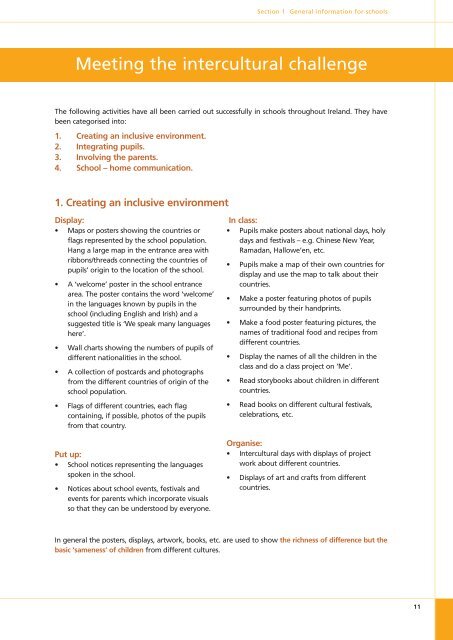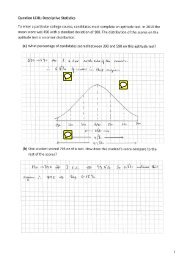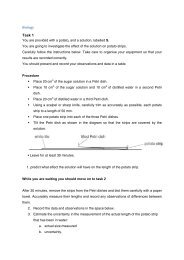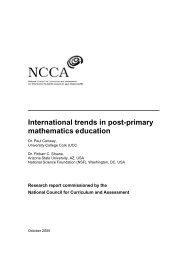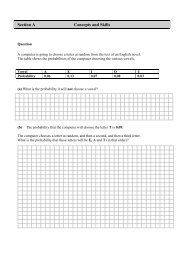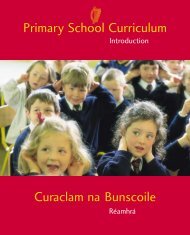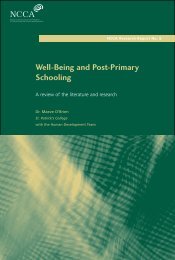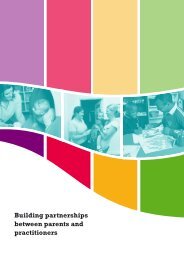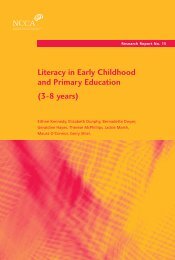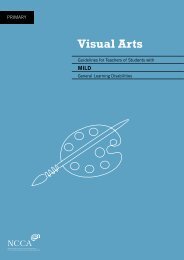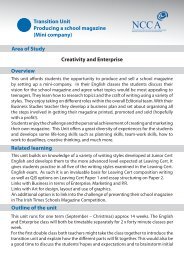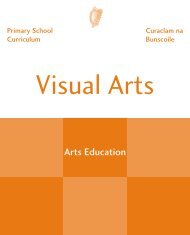Up and Away - National Council for Curriculum and Assessment
Up and Away - National Council for Curriculum and Assessment
Up and Away - National Council for Curriculum and Assessment
Create successful ePaper yourself
Turn your PDF publications into a flip-book with our unique Google optimized e-Paper software.
The following activities have all been carried out successfully in schools throughout Irel<strong>and</strong>. They have<br />
been categorised into:<br />
1. Creating an inclusive environment.<br />
2. Integrating pupils.<br />
3. Involving the parents.<br />
4. School – home communication.<br />
1. Creating an inclusive environment<br />
Section 1 General in<strong>for</strong>mation <strong>for</strong> schools<br />
Meeting the intercultural challenge<br />
Display:<br />
Maps or posters showing the countries or<br />
flags represented by the school population.<br />
Hang a large map in the entrance area with<br />
ribbons/threads connecting the countries of<br />
pupils’ origin to the location of the school.<br />
A ‘welcome’ poster in the school entrance<br />
area. The poster contains the word ‘welcome’<br />
in the languages known by pupils in the<br />
school (including English <strong>and</strong> Irish) <strong>and</strong> a<br />
suggested title is ‘We speak many languages<br />
here’.<br />
Wall charts showing the numbers of pupils of<br />
different nationalities in the school.<br />
A collection of postcards <strong>and</strong> photographs<br />
from the different countries of origin of the<br />
school population.<br />
Flags of different countries, each flag<br />
containing, if possible, photos of the pupils<br />
from that country.<br />
Put up:<br />
School notices representing the languages<br />
spoken in the school.<br />
Notices about school events, festivals <strong>and</strong><br />
events <strong>for</strong> parents which incorporate visuals<br />
so that they can be understood by everyone.<br />
In class:<br />
Pupils make posters about national days, holy<br />
days <strong>and</strong> festivals – e.g. Chinese New Year,<br />
Ramadan, Hallowe’en, etc.<br />
Pupils make a map of their own countries <strong>for</strong><br />
display <strong>and</strong> use the map to talk about their<br />
countries.<br />
Make a poster featuring photos of pupils<br />
surrounded by their h<strong>and</strong>prints.<br />
Make a food poster featuring pictures, the<br />
names of traditional food <strong>and</strong> recipes from<br />
different countries.<br />
Display the names of all the children in the<br />
class <strong>and</strong> do a class project on ‘Me’.<br />
Read storybooks about children in different<br />
countries.<br />
Read books on different cultural festivals,<br />
celebrations, etc.<br />
Organise:<br />
Intercultural days with displays of project<br />
work about different countries.<br />
Displays of art <strong>and</strong> crafts from different<br />
countries.<br />
In general the posters, displays, artwork, books, etc. are used to show the richness of difference but the<br />
basic ‘sameness’ of children from different cultures.<br />
11


